 |
| The Independent Traveler's Newsletter PAGE FIVE |
 |
| The Independent Traveler's Newsletter PAGE FIVE |
| THREE
TOWNS IN BRITTANY continued . . . |
|
|
more about Vannes . . .
Vannes itself is a very interesting city ~ uniquely different from other Breton cities we had visited, and, thanks to the great location of the B&B, a few minutes to the medieval quarter and 'port' known as La Marle (look for the restaurants Le Gambetta and Créperie du Port) or a 15-minute walk down into the more commercial center for restaurants, shops and the post office. We found an exquisite chocolate shop, La Cabosse Créative on rue Saint Nicolas, where we couldn't resist a gift box of handmade chocolates that they wrapped in a lavender ribbon with a huge silky rose instead of a bow. It was lovely, and the gift wrap was at no extra charge. After
lunch in a nice little restaurant where we dined outdoors, we returned
to our B&B; our room was spacious and comfortable with a large
modern en suite whose very 21st century shower took a little technical
expertise to operate. Nevertheless, it was a fine place to stay
with helpful and friendly hosts, copious breakfasts each morning, and a
location that couldn't have been better.
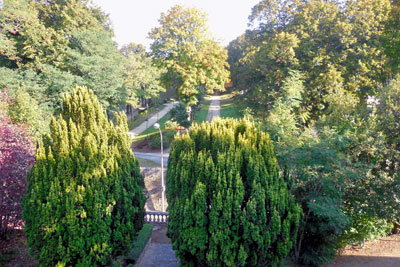 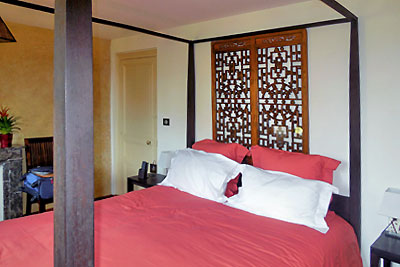 The park as seen
from our window and our room at Maison de la Garenne
Vannes has a long and interesting
history beginning in 56BC following Julius Caesar's victory over the
Veneti as his armies conquered the region. It's original Roman
name was Darioritum, and in the 3rd century a fortification was built
to protect against the Barbarians. The name Venetis replaced
Darioritum in the 5th century with the fall of the Roman Empire, and
the town was pretty much abandoned, becoming a simple outlying
area. Over time the medieval town grew within the
fortifications, and Vannes was chosen by the Church to become a
Bishop's
see (diocese), one of the earliest in Brittany. It was 1532 when
the much-loved King François
I came to Vannes to prepare the treaty between Brittany and
France. Once the Breton parliamentarians were ousted at the end
of
the 17th century by King Louis XIV, the town prospered with growth
beyond the walls and new townhouses being built. The railway's
arrival in 1862 created further urban development as well as the
establishment of two artillery regiments in the early 1870s.
Vannes did not endure much damage in WWII, so much of its medieval
streets and buildings remain. It has about 64,000 inhabitants now
and is a prime tourist attraction, not only for its history and charm
but because of its location on the Golfe du Morbihan. 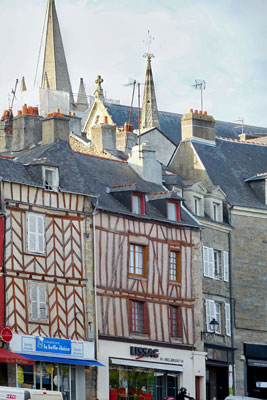 Timber frame (colombage) homes line the older streets in many parts of the city, many side by side with more typical Breton granite houses. Some are over shops in the commercial district, but wander down a little residential side street to see historic old homes. Along La Marle, a narrow stream from the port, we discovered the ancient 'lavoir' or wash house shown here, also in colombage. 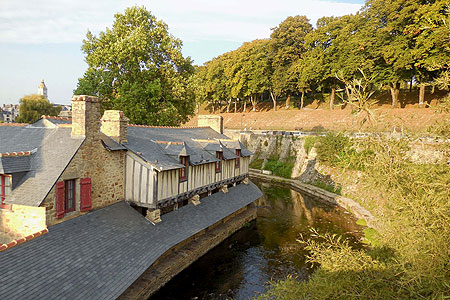 Half-timbered buildings in Vannes and the ancient lavoir near the château Our evening strolls began by crossing the rue Jehan de Bazvalan and a bridge over La Marle to the medieval side of the street ~ exactly where the photo below was taken, and we would proceed through the archway on the other side where one could see the small, squat tower to our right behind the rampart walls. 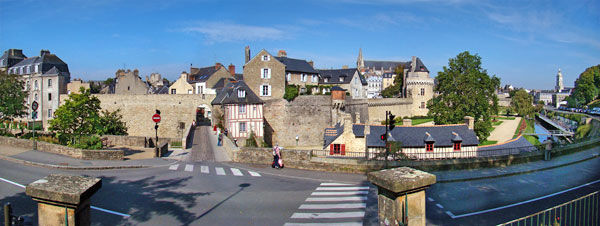 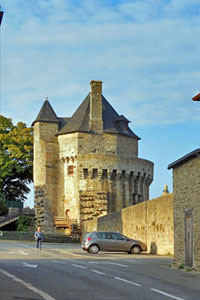 Follow the little winding streets to the left after passing through the archway to come out at the end of the 'port' canal in front of the two restaurants mentioned earlier. This canal comes in from the Golfe du Morbihan shown in the map below, an ideal, sheltered body of water for sailing, dotted with islands and protected from the larger Baie de Quiberon.
Considered an inland sea, the Golfe
du Morbihan is a member of the Club
des Plus Belles Baies due Monde (the Most Beautiful Bays in the
World Club), whose name comes from the Breton 'Mor-Bihan' meaning
'little sea'. The Golfe is filled with many, many islands and
islets, some unoccupied, some rocky and wooded, others where little
fishing hamlets are located. It is a good habitat for flocks of
birds and seashore wildlife. The only way into the Golfe from the
larger Baie de Quiberon, also somewhat sheltered from the Atlantic
Ocean and just north of the island tourist destination of Belle Ile en
Mer, is a narrow bottleneck between Port-Navalo en Arzon and
Locmariaquer ~ one kilometer in width. Vannes, only 25 kilometers from the
sea, offers easy access to the bay and the islands, many of which have
nice sandy beaches. Natives and visitors alike are encouraged to
go sailing or spend time along the coast simply enjoying nature,
watching sea birds or driving the scenic route on the mainland that
circles the bay. SECRET REMNANTS OF 13th CENTURY PARIS
Secret, But Readily
Visible ~ If You Know What
You're Looking At by Arthur Gillette At the beginning of the 13th
century, King Philip Augustus built a city wall around Paris'
Left Bank.
Some of its many vestiges are well known and often visited. Others remain 'secretive' , unknown although readily visible to passersby . . . if they know what they are looking at! In these six short takes FRANCE On Your Own shows you the way to some of them, placed like a necklace of ancient beads semi-circling the southern half of the city practically from Seine to . . . .Seine.
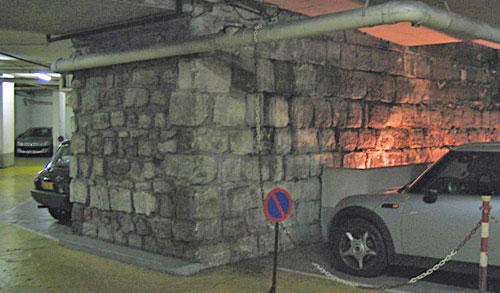
In the much-used underground public
parking you can see this surprising remnant.
-
Un Dimanche à Paris Salon de
Thé
Along
rue Monsieur-le-Prince (near the corner with bd. St-Michel) Strollers here can't fail to notice the
level difference between the street and the sidewalk, some four feet
lower. The latter is in fact the Wall's external moat, only
partly filled in over more than eight centuries. 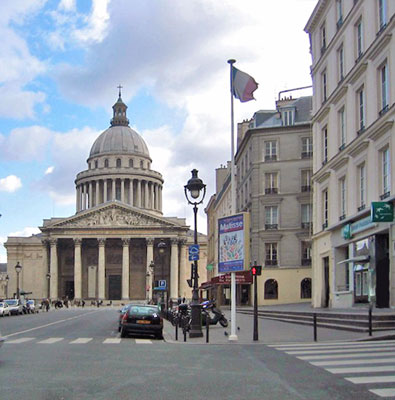 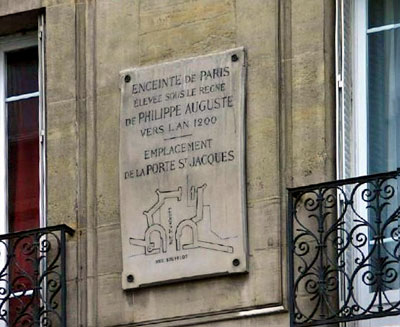 rue Soufflot near the corner with rue St-Jacques, at those crossroads a plaque identifies it as the site of a major gate in the Philip Augustus Wall. Rue Soufflot was widened in the 19th century to enable an impressive view of he Pantheon, built in the 18th century by the architect for whom the street is named. All adjoining houses are parallel to the street except for the one in the right foreground that is perpendicular to the Wall.
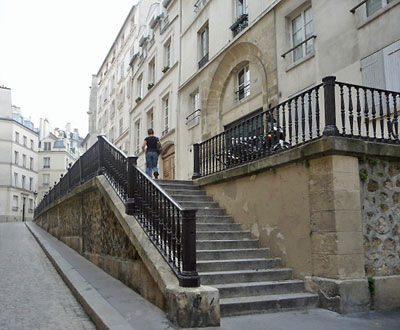
rue
des Fossés
St-Jacques A
few steps southwards on rue St-Jacques around the corner from rue
Soufflot is St. James Trenches Street, so-named for an
obvious reason:
it is the Wall's moat adjoined by extra-muros territory.
We wish you a successful, visible, secret hunt! Contact
Arthur
Gillette to take advantage of his amazing knowledge of Paris
by enjoying one or more of his Paris Through the Ages Strolls. Visit our Marketplace page for a complete list of strolls and information about Arthur. Email: pouchkine38@gmail.com
DISCLAIMER: You have received this newsletter because your email address is on our Opt-In mailing list, i.e., you have requested to receive FRANCE On Your Own ©. If you would like to discontinue receipt of this newsletter, please send an email to publisher@franceonyourown.com with "unsubscribe" on the Subject line. Unless indicated otherwise, photos, graphics, artwork and text in the FRANCE On Your Own © newsletter are all the property of Cold Spring Press and FRANCE On Your Own © and cannot be copied, duplicated or used in any manner by anyone without the express written permission of Cold Spring Press. FRANCE On Your Own © is published online by Cold Spring Press, P O Box 26098, San Diego, California 92196-0098. This publication is copyrighted and no portions of the text, artwork, graphics or photographs may be reproduced or distributed in any form or by any means or stored in a database or retrieval system without the written permission of the Publisher. For more information about FRANCE On Your Own ©, visit our web site at http://www.franceonyourown.com. Recommendations made in this newsletter are based upon the personal experiences of the Publishers or contributing writers solely to provide information to subscribers. Cold Spring Press and FRANCE On Your Own © make no endorsements nor are any guarantees or promises of satisfaction given or implied. Any and all information is correct to the best of our knowledge, and the Publishers accept no responsibility for errors and/or omissions. The responsibility lies entirely with the traveler to obtain current information regarding accommodations, availability, schedules, prices, reservations, or any other pertinent details. We do not guarantee the historical accuracy of the contents of articles in this newsletter. Historical accuracy is dependent upon one's sources of information -- and contradictions often exist among those sources. Links to other web sites or email addresses are provided for informational purposes only and do not imply any guarantees of service or endorsement of any organization or their business practices. FRANCE On Your Own © is electronically transmitted via email. To add your email address to our database for this FREE newsletter, send an email to info@franceonyourown.com, and please put Subscribe in the subject line. We do not share email addresses with any other organization. BACK ISSUES of the print version of FRANCE On Your Own © and Free online back issues are available on our web site at http://www.franceonyourown.com/Archives.htm. ©1998-2015
Cold Spring Press All Rights Reserved |
|
 previous
page
previous
page |